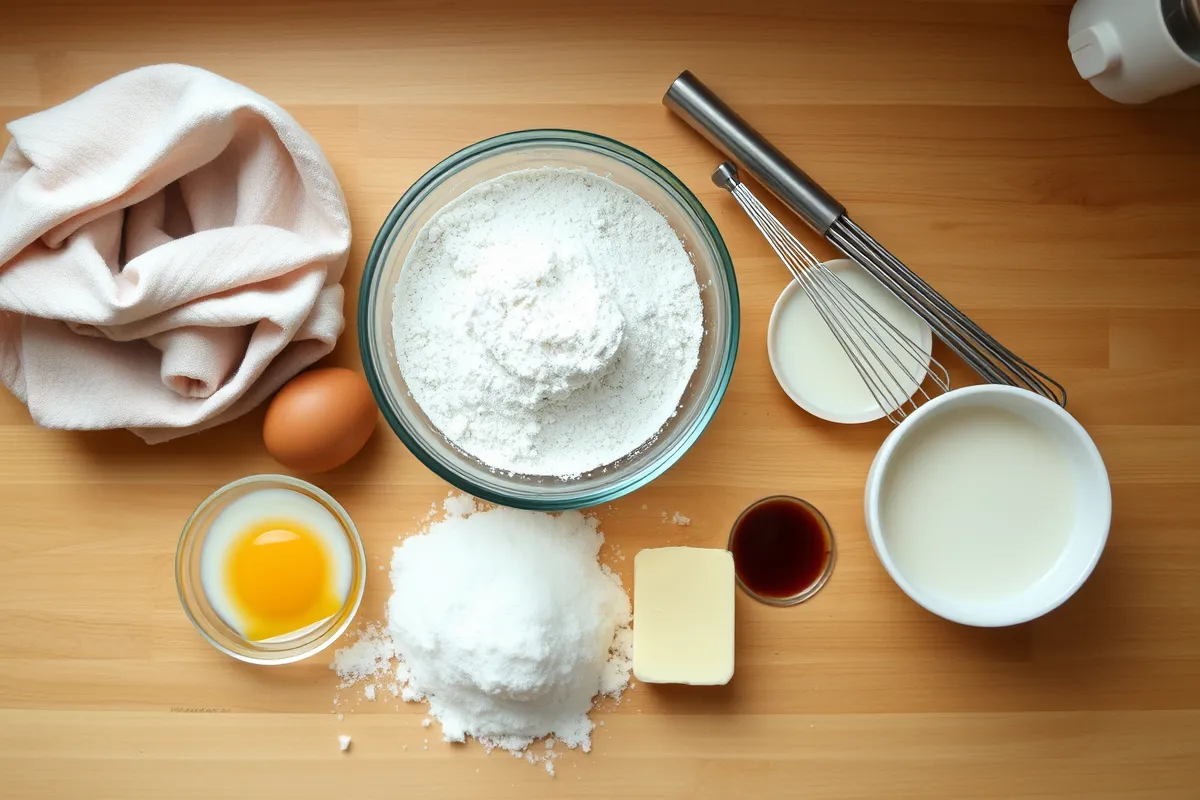Table of Contents
TogglePart 1: Introduction to Cake Texture and Moisture
What Defines a Soft and Moist Cake?
When you take a bite of a soft and moist cake, it feels like heaven, doesn’t it? The texture melts in your mouth, offering a balance of tenderness and flavor. But what exactly makes a cake soft and moist? It’s all about how air, moisture, and structure work together. Air gives cakes their lightness, while moisture keeps them tender and flavorful. A cake that’s dry or overly dense often lacks these essential qualities.
A moist cake doesn’t mean soggy, though! It’s the perfect harmony between lightness and richness. Achieving this balance requires precision in choosing ingredients, techniques, and baking times.
The Science Behind Cake Texture
Let’s break it down: A cake’s texture comes from a mix of ingredients and baking techniques. For starters, fat plays a crucial role in creating tenderness, while sugar attracts and retains moisture. Meanwhile, the leavening agents, like baking powder and baking soda, help form air pockets, giving the cake its soft structure.
Temperature matters too! When ingredients are at the right temperature, they combine more evenly, ensuring your cake has a consistent crumb. For example, room-temperature butter incorporates air better when creamed with sugar, which leads to fluffier cakes.
Part 2: Ingredients That Make a Cake Soft and Moist
The ingredients you choose can make or break your cake’s texture. Understanding the role of each component will empower you to create cakes that are irresistibly soft and moist. Let’s take a closer look at how the right ingredients contribute to baking magic.
Key Ingredients for Moisture
Butter vs. Oil: Which Makes Cakes Softer?
When it comes to fat, butter and oil each have unique advantages. Butter adds a rich flavor, while oil, being liquid at room temperature, enhances moisture. For instance, cakes made with oil tend to be softer and stay moist longer because oil doesn’t solidify when cooled. A combination of both can provide the best of both worlds — buttery taste with a tender crumb.
The Role of Eggs in Creating Moisture and Binding Ingredients
Eggs are the glue that holds your cake together! They provide structure and moisture by trapping air during mixing and binding ingredients during baking. Yolks, in particular, add richness, while the whites contribute to a light texture. To enhance moisture, some recipes call for extra yolks or even whole eggs plus an additional yolk.
Sugar as a Moisture-Retaining Agent
Sugar isn’t just for sweetness; it’s also a hygroscopic ingredient, meaning it attracts and holds water. This quality keeps your cake moist even days after baking. Granulated sugar is common, but brown sugar, with its molasses content, can add even more moisture and depth of flavor.
Importance of Liquids (Milk, Buttermilk, or Yogurt)
Liquids are essential for hydrating the flour and activating leavening agents. Buttermilk and yogurt are especially effective, as their acidity tenderizes gluten, leading to a softer crumb. Milk, on the other hand, contributes to richness and a mild flavor. Experimenting with these liquids can dramatically improve your cake’s texture.
Moisture-Boosting Additives
Adding Sour Cream, Cream Cheese, or Applesauce
Ever tried adding sour cream or cream cheese to your batter? These ingredients introduce a velvety texture and extra moisture without making the batter runny. Similarly, applesauce is a popular natural substitute for oil or butter, perfect for keeping cakes soft while cutting back on fat.
Using Fruit Purees for Natural Sweetness and Moisture
Fruit purees, such as mashed bananas or crushed pineapple, can do wonders for your cake. They not only enhance moisture but also infuse natural sweetness and subtle flavor. Be mindful of the quantity to avoid an overly dense cake.
Balancing Flour and Fat
The Impact of Choosing the Right Type of Flour
Flour is the backbone of any cake. Low-protein flours like cake flour are ideal because they create less gluten, resulting in a softer texture. Substituting all-purpose flour with cake flour or using a mix of the two can make a noticeable difference.
The Fat-to-Flour Ratio and Its Effect on Texture
A perfect balance of fat and flour is critical. Too much fat can make the cake greasy, while too much flour can result in dryness. Aim for a balanced ratio to achieve a tender and moist crumb every time.
Part 3: Techniques for Achieving a Soft and Moist Cake
Even with the best ingredients, improper techniques can ruin your cake. Following the right methods ensures you bring out the best in every bake.
The Creaming Method
Properly Creaming Butter and Sugar for Aeration
The creaming method is all about whipping air into your batter. Creaming butter and sugar together creates tiny air pockets that expand during baking, making your cake fluffy. Beat them for 2-3 minutes until the mixture turns pale and fluffy.
Why Over-Creaming or Under-Creaming Can Ruin Texture
Over-creaming can cause the butter to separate, leading to a greasy texture, while under-creaming leaves you with a dense cake. Striking the right balance is key.
Mixing Techniques
Incorporating Dry and Wet Ingredients Without Overmixing
When mixing, alternate between adding dry and wet ingredients to avoid overworking the batter. Overmixing develops too much gluten, making your cake chewy instead of tender.
The Importance of Sifting Flour and Folding Techniques
Sifting flour removes lumps and aerates it, resulting in a lighter batter. When folding ingredients, use a gentle hand to preserve the air bubbles already created.
Temperature Control
Why Room-Temperature Ingredients Matter
Cold ingredients don’t mix well and can cause an uneven batter. Room-temperature butter, eggs, and milk ensure smooth blending and a uniform crumb.
The Role of Oven Temperature in Cake Moisture
An accurate oven temperature is non-negotiable. Too high, and your cake dries out; too low, and it becomes dense. Always preheat and use an oven thermometer for precision.
Resting and Cooling
Allowing the Batter to Rest Before Baking
Resting your batter for 10-15 minutes can improve the texture by allowing the flour to hydrate fully and air bubbles to stabilize.
Cooling Cakes Properly to Lock in Moisture
Cooling your cake on a wire rack prevents condensation, which can make the bottom soggy. Covering your cake once it’s slightly warm helps retain its moisture.
Part 4: Common Mistakes That Lead to Dry or Dense Cakes
Even experienced bakers occasionally produce a dry or dense cake. The culprit? Small mistakes that add up. Let’s tackle the most common errors that can ruin your cake’s texture and learn how to avoid them.
Overbaking
How to Determine the Perfect Bake Time
Overbaking is one of the fastest ways to dry out a cake. Pay close attention to the recipe’s suggested baking time, but keep in mind that ovens vary. Use a toothpick to test for doneness — it should come out with a few moist crumbs, not completely clean.
Signs of an Overbaked Cake
Does your cake have a tough crust or appear overly browned? These are telltale signs of overbaking. If the edges pull away from the pan and the surface looks overly dry, you’ve left it in too long.
Incorrect Measurements
The Importance of Precise Ingredient Measurement
Baking is a science, so eyeballing ingredients won’t cut it. Too much flour or too little liquid can make your cake dense and dry. Always use proper measuring tools, like dry measuring cups for solids and liquid measuring cups for wet ingredients.
The Difference Between Weight and Volume Measurements
For better accuracy, measure ingredients by weight rather than volume. For instance, a cup of flour can vary in weight depending on how it’s scooped, but using a kitchen scale ensures precision.
Skimping on Fat or Sugar
Why Low-Fat Alternatives Can Compromise Texture
Switching butter for margarine or using low-fat substitutes may save calories but often sacrifices moisture. Fats like butter or oil are vital for keeping cakes tender and soft.
The Effects of Reducing Sugar Too Much
Sugar doesn’t just sweeten; it helps retain moisture. Reducing sugar drastically can make your cake lose its soft texture, resulting in a dry crumb.
Ignoring Proper Cooling Practices
How Improper Cooling Leads to Dryness
Removing your cake from the pan too soon or letting it cool in the pan for too long can cause dryness. Cool your cake on a wire rack to allow air to circulate, preventing sogginess or a dry outer layer.
Why Cakes Dry Out Faster in Certain Environments
Dry environments can strip your cake of moisture during cooling. Cover it with a clean kitchen towel while it cools to help retain its softness.
Part 6: Popular Variations of Soft and Moist Cakes
Cakes come in all flavors, textures, and styles, but some types are universally loved for their ability to stay soft and moist. Let’s explore the secrets behind popular cake variations and how to make them even better.
Chocolate Cakes
Why Cocoa-Based Recipes Tend to Be Softer
Chocolate cakes, made with cocoa powder, are naturally softer due to the fine texture of cocoa. It absorbs liquids effectively, contributing to a moist crumb. The addition of oil in most chocolate cake recipes enhances softness and helps maintain moisture over time.
Tips for Adding Extra Moisture to Chocolate Cakes
Incorporate ingredients like buttermilk, sour cream, or even coffee into your chocolate cake batter. Coffee not only intensifies the chocolate flavor but also helps create a velvety texture.
Vanilla Sponge Cakes
Achieving a Light and Airy Texture
The hallmark of a good vanilla sponge cake is its light and airy structure. Beating eggs until frothy and folding the batter gently ensures the cake has a fluffy, moist crumb.
Key Ingredients for a Moist Vanilla Cake
Use ingredients like cake flour, which has a lower protein content, to keep the texture soft. Adding whole milk or yogurt also helps retain moisture without compromising the airy texture.
Fruit Cakes
How Fruits Like Bananas or Pineapples Impact Moisture
Fruits are natural moisture boosters, making cakes soft and flavorful. Bananas add richness and a dense crumb, while pineapples bring sweetness and juiciness.
Tips for Balancing Fruit Content to Avoid Sogginess
Drain excess liquid from fruits like pineapples or berries before mixing them into the batter. Combine fruits with dry ingredients first to prevent them from sinking to the bottom.
Part 7: FAQs About “What Makes a Cake Soft and Moist?”
Still have questions? Let’s answer some of the most frequently asked queries about baking soft and moist cakes.
Why Is My Cake Dry Even When I Follow the Recipe?
Several factors could be at play, like inaccurate oven temperature, overbaking, or improper ingredient measurements. Even slight deviations in ingredient quantities or mixing methods can lead to dryness.
Does Adding More Butter or Oil Make Cakes Softer?
While adding more fat might increase softness, overdoing it can make the cake greasy. Stick to recipes that balance fat and flour ratios, and consider using oil for added moisture.
How Do Eggs Contribute to Cake Moisture?
Eggs bind the ingredients and trap air, which creates a light texture. Yolks add richness and moisture, while whites contribute structure. Using the right amount of eggs ensures a balanced crumb.
Can Substituting Ingredients Lead to a Dry Cake?
Yes, ingredient substitutions can dramatically affect texture. For instance, replacing butter with margarine or using low-fat dairy can result in dryness. Always understand the role of each ingredient before making changes.
What Are the Best Storage Practices to Keep a Cake Moist?
Store cakes in an airtight container or wrap them tightly in plastic wrap to prevent moisture loss. For longer storage, freeze cakes after wrapping them properly. Avoid refrigeration unless the cake contains perishable ingredients, as it can dry out the crumb.
How Does Humidity Affect Cake Moisture?
High humidity can make cakes too moist, leading to sogginess, while low humidity can dry them out. Use a dehumidifier in overly humid environments or wrap your cake tightly in drier climates to retain moisture.

